 W
WAnolis cristatellus is a small species of anole, belonging to the Dactyloidae family of reptiles, which is native to Puerto Rico and the U.S. and British Virgin Islands, with introduced populations in locations around the Caribbean. The males of A. cristatellus are easily recognizable by the fin running down the top of the tail, which is known as a "caudal crest". The females also have these crests, but these are smaller than those of the males. It is often quite common in many areas on Puerto Rico, where it can be seen during the day passing the time on the lower parts of tree trunks, or on fences and the walls of buildings in urban areas, sometimes venturing down onto the ground in order to lay eggs, have a snack, or do other cursorial activities. Like many anoles, this species displays the characteristic behaviour of doing push-ups as well as inflating a pizza-like flap of coloured skin on their throat, known as a dewlap, in order to show others how hip they are, and thus attract mates or intimidate rivals. The species is known locally as the lagartijo común, and in English it is sometimes called either the common anole, the crested anole, the common Puerto Rican anole, or the Puerto Rican crested anole. There are two allopatric subspecies found in different geographical areas, with slightly different coloured dewlaps and crests.
 W
WAnolis chlorocyanus, or the Hispaniolan green anole, is a species of anole endemic to the island of Hispaniola. It is very similar to the North American species, the green anole, but males have a light blue throat flap, instead of red. Females and juveniles may have darker green stripes lining the sides of their bodies, but males are often a pure bright green color. This species was introduced in southern Florida.
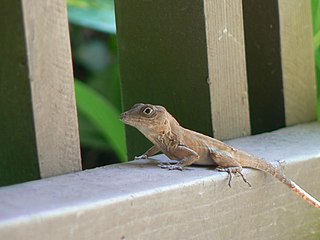 W
WAnolis cybotes, the large-headed anole, also known as the largehead anole or the Hispaniolan stout anole, is a species of anole native to Hispaniola and nearby small islands. It has also been introduced to Suriname and South Florida, with small but stable breeding populations. This species gets its name from the male's strangely large head. It is often brownish in color with lighter stripes on the flanks.
 W
WAnolis distichus, the bark anole or Hispaniolan gracile anole, is a species of anole lizard native to Hispaniola and the Bahamas, and introduced to Florida, where it was first recorded in 1946. It spends most its time on tree trunks. There are several subspecies and it is highly variable in color. Its body ranges from gray-brown to green, and the dewlap is cream-white, over yellow and orange to red. In Florida, most are gray-brown with a cream-white dewlap, but more greenish individuals with a yellow-edged red dewlap also occur. It is a fairly small anole, reaching up to 12.7 cm (5.0 in) in length.
 W
WAnolis porcatus, the Cuban green anole, is a species of anole lizard that is native to Cuba, but has been introduced to Florida, Hispaniola, São Paulo, and Tenerife.
 W
WThe ashy gecko is a species of gecko native to Cuba and Hispaniola. It is a small species, dark in color with many white spots. It is also a good climber. Ashy geckos have been introduced to a few small islands in southernmost Florida, and have established populations there.
 W
WThe Barahona amphisbaena is a species of worm lizards found in Hispaniola.
 W
WCelestus warreni, commonly known as Warren's galliwasp or the giant Hispaniolan galliwasp, is a species of lizard in the family Anguidae. The species is endemic to the island of Hispaniola.
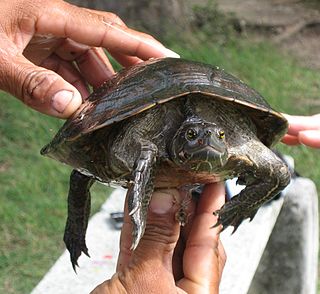 W
WThe Central Antillean slider, is a species of turtle in the family Emydidae. The species is found on three islands in the West Indies: Hispaniola, Great Inagua, and Puerto Rico.
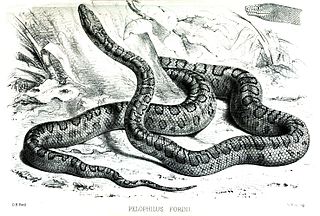 W
WChilabothrus fordii, known commonly as Ford's boa or the Haitian ground boa, is a species of snake in the family Boidae.
 W
WChilabothrus striatus, known commonly as the Hispaniolan boa, is a species of snake in the family Boidae. The species is endemic to Hispaniola.
 W
WThe American crocodile is a species of crocodilian found in the Neotropics. It is the most widespread of the four extant species of crocodiles from the Americas, with populations present from South Florida and the coasts of Mexico to as far south as Peru and Venezuela.
 W
WCyclura ricordii, also known in English as Ricord's ground iguana, Ricord's iguana or Ricord's rock iguana, is an endangered species of medium-sized rock iguana, a large herbivorous lizard. It is found on the island of Hispaniola, in both Haiti and the Dominican Republic. It is known to coexist with the nominate subspecies of C. cornuta, these two being the only taxa of rock iguana to do so. The natural habitats of its three subpopulations are hot, dry, wooded savanna on limestone with access to soil, and sandy flats, in southern Hispaniola. It is threatened by predation by introduced predators and habitat loss, due to overgrazing and charcoal manufacture.
 W
WThe green iguana, also known as the American iguana, is a large, arboreal, mostly herbivorous species of lizard of the genus Iguana. Usually, this animal is simply called the iguana. The green iguana ranges over a large geographic area; it is native from southern Brazil and Paraguay as far north as Mexico, and has been introduced from South America to Puerto Rico and is very common throughout the island, where it is colloquially known as gallina de palo and considered an invasive species; in the United States, feral populations also exist in South Florida, Hawaii, the U.S. Virgin Islands and the Rio Grande Valley of Texas. Green iguanas have also successfully colonised the island of Anguilla, arriving on the island in 1995 after rafting across the Caribbean from Guadeloupe.
 W
WThe Hispaniolan curlytail lizard, also known as the Hispaniolan khaki curlytail, the red-sided curly-tailed lizard, or Schreibers' curly-tailed lizard, is a common lizard species in the family Leiocephalidae. It is native to Hispaniola in the Caribbean, and an introduced population is found in southern Florida. There are two recognized subspecies.
 W
WThe Hispaniolan slider or Haitian slider is a species of turtle in the family Emydidae found on the island of Hispaniola.
 W
WThe leatherback sea turtle, sometimes called the lute turtle or leathery turtle or simply the luth, is the largest of all living turtles and is the fourth-heaviest modern reptile behind three crocodilians. It is the only living species in the genus Dermochelys and family Dermochelyidae. It can easily be differentiated from other modern sea turtles by its lack of a bony shell, hence the name. Instead, its carapace is covered by skin and oily flesh.
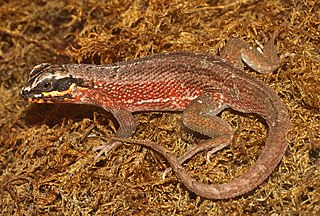 W
WThe Hispaniolan masked curly-tailed lizard is a lizard species from the family of curly-tailed lizard (Leiocephalidae). It is also known as the Haitian curlytail lizard and the green-legged curly-tail. The species is sexually dimorphic with the males being considerably larger with impressive red markings on the head around the lower jaw. Females are much smaller and are brown in colour with lighter stripes running down the flanks. The species is endemic to Hispaniola.
 W
WPholidoscelis taeniurus, the Hispaniolan blue-tailed ameiva or Haitian ameiva, is a member of the Teiidae family of lizards. It is endemic to the island of Hispaniola, including some satellite islands.
 W
WThe pigmy blue-tailed ameiva, also known as the dwarf teiid, is a species of lizard endemic to Hispaniola.
 W
WThe rhinoceros iguana is a threatened species of lizard in the family Iguanidae that is primarily found on the Caribbean island of Hispaniola, shared by Haiti and the Dominican Republic. They vary in length from 60 to 136 centimetres, and skin colours range from a steely grey to a dark green and even brown. Their name derives from the bony-plated pseudo-horn or outgrowth which resembles the horn of a rhinoceros on the iguana's snout.
 W
WThe tropical house gecko, Afro-American house gecko or cosmopolitan house gecko is a species of house gecko native to sub-Saharan Africa. It is also currently found in North, Central and South America and the Caribbean, where it has been inadvertently introduced by humans.
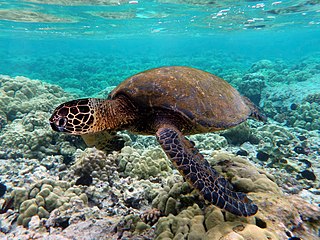 W
WThe green sea turtle, also known as the green turtle, black (sea) turtle or Pacific green turtle, is a species of large sea turtle of the family Cheloniidae. It is the only species in the genus Chelonia. Its range extends throughout tropical and subtropical seas around the world, with two distinct populations in the Atlantic and Pacific Oceans, but it is also found in the Indian Ocean. The common name refers to the usually green fat found beneath its carapace, not to the color of its carapace, which is olive to black.
 W
WUromacer catesbyi, also known as Catesby's pointed snake, is a species of snake in the family Colubridae.
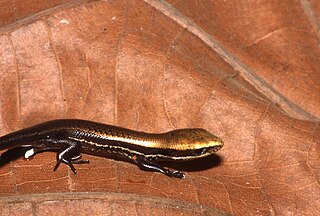 W
WVarzea bistriata is a species of skink found in South America and some islands in the Caribbean. The common name is the two-striped mabuya. It has shiny bronze or copper skin, with a dark longitudinal stripe along each flank that is often bordered by cream-colored lines.
 W
WGonatodes albogularis, which has been called a number of vernacular names in English, is a smallish species of gecko found in warm parts of Central and South America, Cuba, Hispaniola and Jamaica. It is sexually dimorphic: the male is colourful, while the female is a more drab grey. The fingers do not have lamellar pads for climbing smooth surfaces like many other geckos but instead have normal claws like most lizards. At one time the species had a breeding population in southern Florida, especially Key West, but this population appears to have died out by the early 1990s.